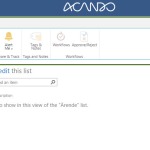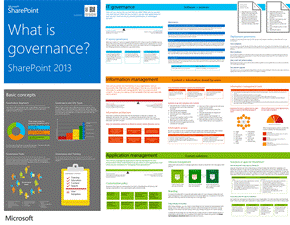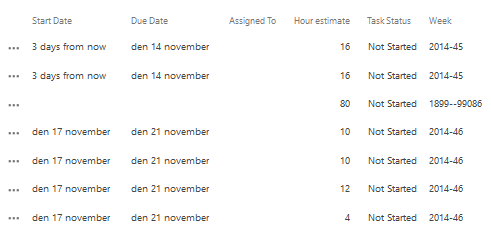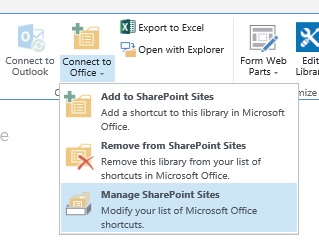Note: this post is written specifically for SharePoint 2013.
Sometimes it is necessary to add a snippet of code to just one page. Examples could be:
- Alternative CSS for just that page, i.e. to style a specific element
- Add a snippet of HTML and/or JavaScript, such as for a Google Maps or Youtube embed
- Add a piece of CSS to hide the left navigation on specific pages
- Add the Open In Explorer Link to a page
There are technically a number of ways to achieve this:
- Paste the code directly into the page contents (does not work)
- Paste the code into the the HTML source of the Content Editor Web Part (can work, depending on SP version and code)
- Use the Embed command (can work, situational)
- Save the code in a text file, save it somewhere on your SharePoint site collection and call the text file via the Content Editor Webpart (my preferred method)
Option #4 is my favorite for a number of good reasons:
- You can save the code centrally and then call it from multiple places without needing to replicate it
- By saving it centrally, you only need to update it once if there are changes or updates
- By saving it in the content database, you can access it from SharePoint Designer or similar, meaning you do not need to keep downloading-updating-uploading
- It works consistently across all versions of SharePoint from SharePoint 2007 up to Office 365
For this example, I will be using a simple JavaScript which shows copyright information, in this case from 2010 to the current year. This allows the copyright to be kept up to date:
<p>All right reserved ©
<script>
var cur = 2010;
var year = new Date();
if(cur == year.getFullYear()) year = year.getFullYear();
else year = cur + ' - ' + year.getFullYear();
document.write(year);
</script>
</p>
Option 1: Paste the code directly into the page content
You can paste the code directly into the page content.
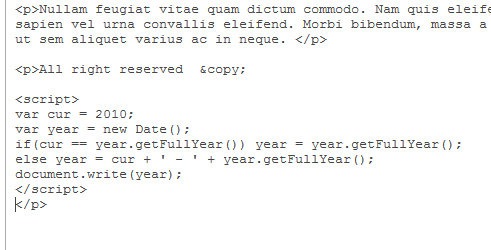
However, once you save the page and view it, you will see that SharePoint does not realize that it is code it needs to render in some way.
Conclusion: do not place code directly in the page content as it does not work.
Option 2: Edit source in rich text area / CEWP
In most content editor webparts and all rich text areas, there is a button in the ribbon called “Edit source”. This is great for quick fixes when content has gotten out of hand. In older versions of SharePoint, you could also use it to embed extra code.

You can easily paste your code straight into the Edit HTML window.
However, once you save, SharePoint lets you know that the code that it does not approve of has been stripped.

In this case, some of the embedded code has been stripped out.

Sometimes SharePoint will strip out all of it and sometimes it will only strip out parts which can cause an odd result. When it doubt, check back into the HTML source to see what has happened with your code and if it is still 100% intact.
Conclusion: while this used to work under some older SharePoint versions, it is generally not a reliable solution for SharePoint 2013.
Option #3: Using the Embed command
SharePoint 2013 includes an Embed command in the ribbon which can be great for adding code snippets to your page:

After clicking the command, you are prompted to insert your code and given a preview:

SharePoint creates a Script Editor webpart on the page for you. It even includes an “Edit Snippet” button, so you can go back and edit the code later.

The JavaScript is being displayed correctly in the webpart and also on publishing the page.
Conclusion: in my experience, this works but is dependent on the complexity of the code. Test well before using.
Option 4: save as a text file, call via CEWP
I have saved the JavaScript into a file called copyright.html. The file extension can help SharePoint determine how to parse the code when it is called, but you may need to experiment depending on your code – I have had good results from using txt, html and js extensions in the past.
Here is the file in Notepad++:
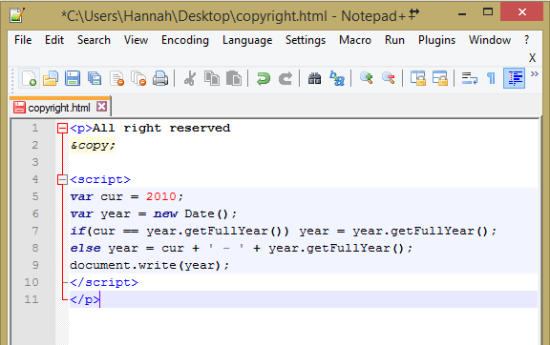
In this demo, I uploaded the HTML file to the document library on the same site as the page we are working with.

Tip: I tend to use the following rules of thumb as to where to upload these kinds of files:
- Think about if you want to save it in the standard Document library, or if you want to create a dedicated document library called “Scripts” or similar
- If the file will be called from just one single site, save it on the site
- if the file will be used across just one site collection, consider saving it at the root of the site collection or in the Style Library of that site collection (i.e. Styles/Scripts)
- If using across multiple site collections, choose the most logical place for it, i.e. on a root site collection
Next, place a Content Editor Web Part (CEWP) on the page and edit the webpart settings. At the top, add the link to the file and click “Apply” to save the changes.
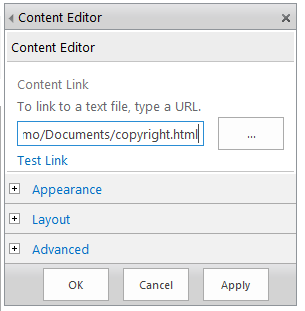
The content should immediately display in the CEWP on the page.

Tip: if you wish to use the same webpart in many places, you could export the configured CEWP and import it as a custom webpart. You can then place it on a page and it will already be configured for you.
Conclusion: this is my favorite method due to the central storage of the files, ease of editing the files and reusability.



